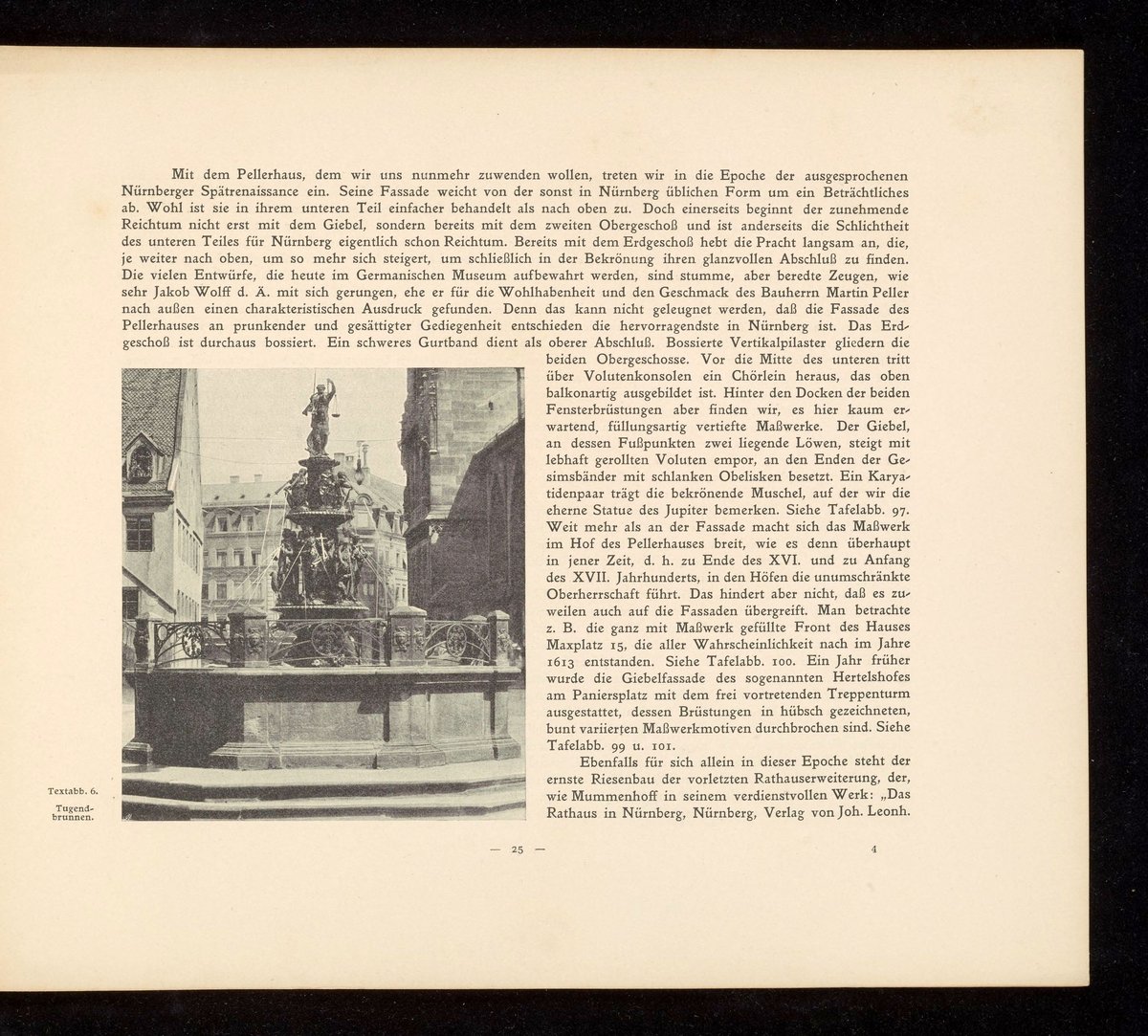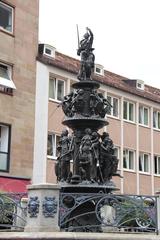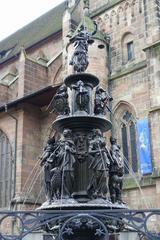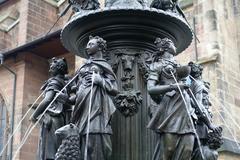
Brunnen Nuremberg: Visiting Hours, Tickets, and Historical Significance Guide
Date: 14/06/2025
Introduction: Nuremberg’s Brunnen—History and Cultural Importance
Nuremberg’s Brunnen (fountains) are far more than decorative features; they are enduring symbols of the city’s medieval legacy, artistic innovation, and communal spirit. These fountains, shaped by Nuremberg’s unique geological landscape and historical context, originally served as essential water sources and have since evolved into iconic landmarks. They embody civic pride, religious symbolism, social commentary, and artistic achievement.
Among the most celebrated is the Schöner Brunnen, a Gothic masterpiece reflecting the city’s historical ambitions and intellectual vibrancy through its elaborate statuary. The modern Ehekarussell-Brunnen, inspired by the poetry of Hans Sachs, highlights Nuremberg’s openness to thought-provoking public art.
With approximately fifty decorative fountains concentrated in the pedestrian-friendly Old Town, visitors can enjoy historical insight and aesthetic pleasure throughout the year. Most are freely accessible at all times, and guided tours are available for those seeking deeper understanding. Nuremberg’s dedication to preservation ensures these monuments remain vivid storytellers, enhanced by amenities like wheelchair access, interpretive signage, and seasonal events such as the famed Christkindlesmarkt (global-geography.org, tourismus.nuernberg.de, explorial.com).
This guide explores the historical evolution, cultural significance, practical visitor information, and unique traditions of Nuremberg’s Brunnen, equipping travelers with essential insights for an enriching experience. Whether your interest lies in Gothic architecture, urban legends like the golden ring, or modern artistic expression, Nuremberg’s fountains offer a bridge between past and present.
Contents
- Historical Evolution and Symbolic Roles of Nuremberg’s Brunnen
- Integration into Public Spaces
- Visitor Information: Hours, Tickets, Accessibility, and Events
- Legends and Traditions
- Preservation and Restoration
- Must-See Brunnen and Nearby Attractions
- FAQs
- Schöner Brunnen: Detailed Visiting Guide
- Ehekarussell-Brunnen: History, Art, and Visitor Tips
- Essential Tips for Exploring Nuremberg’s Brunnen
- Summary and Recommendations
- References
Historical Evolution of Brunnen in Nuremberg
Nuremberg’s fountains are deeply integrated into the urban landscape, reflecting centuries of civic development. The city’s sandstone geology supported a network of wells and overflow fountains, ensuring a reliable water supply critical to Nuremberg’s growth in the Middle Ages (global-geography.org). By the 14th century, public fountains like the Schöner Brunnen (built 1385–1396 by Heinrich Beheim) symbolized the city’s wealth and cultural ambition (wikipedia.org). Today, nearly fifty decorative fountains enhance the Old Town’s historic ambiance.
Functional and Symbolic Roles
- Water Supply & Health: Brunnen originally provided vital public access to potable water, supplementing private wells via aqueducts that served hospitals and squares (global-geography.org).
- Civic Identity: Monumental fountains, notably the Schöner Brunnen with its 40 painted figures, projected Nuremberg’s intellectual and imperial stature (explorial.com).
- Artistic Landmarks: The city’s fountains span Gothic, Renaissance, and modern styles, with masterpieces like the Fountain of Virtue and the expressive Ehekarussell reflecting evolving artistic trends (meticulousmeanderings.com).
Integration into Public Spaces
Fountains are strategically sited in main squares and along pedestrian routes, enhancing the city’s social life. The Schöner Brunnen stands in Hauptmarkt, the heart of daily markets and major festivals, and is a popular meeting point (adventurebackpack.com). Seasonal events like the Christkindlesmarkt transform these spaces, with fountains illuminated and animated by festive gatherings (angiestravelroutes.com).
Visitor Information: Visiting Hours, Tickets, Accessibility, and Events
- Visiting Hours: Nearly all Brunnen, including the Schöner Brunnen and Ehekarussell, are outdoors and accessible 24/7 (explorial.com).
- Tickets: No tickets are needed for viewing the fountains. Guided tours, which provide deeper historical and artistic context, can be booked online or at tourist centers.
- Accessibility: Hauptmarkt and surrounding areas are wheelchair-accessible, with smooth paths facilitating ease of movement.
- Special Events: Fountains often serve as focal points for festivals and are illuminated for seasonal events such as the Christmas Market (germanythingstodo.com).
Legends and Traditions
- Golden Ring Tradition: At the Schöner Brunnen, spinning the small brass ring in the fence three times is believed to bring good luck—a beloved local ritual (explorial.com).
- Artistic Debate: The Ehekarussell, crafted by Jürgen Weber in 1984, uses dramatic bronze sculptures to depict the complexities of marriage, sparking ongoing dialogue about public art (inuremberg.com).
Preservation and Restoration
- Impact of War: Many fountains sustained damage during WWII. The Schöner Brunnen was protected in concrete and later restored, with original figures now housed in the Germanisches Nationalmuseum (wikipedia.org, angiestravelroutes.com).
- Ongoing Care: The city invests in regular maintenance, enhanced signage, and visitor education to preserve these cultural treasures (explorial.com).
Must-See Brunnen and Nearby Attractions
- Schöner Brunnen: Hauptmarkt’s Gothic gem—don’t miss the golden ring.
- Ehekarussell: Modern bronze fountain at Ludwigsplatz, exploring marriage themes.
- Fountain of Virtue: Near St. Lorenz, a Renaissance symbol of civic values.
Nearby sites: Frauenkirche, Nuremberg Castle, city bridges, and museums (angiestravelroutes.com).
FAQs
Q: Are tickets required to see the fountains?
A: No, viewing is free. Fees only apply to guided tours or museum visits.
Q: Are the fountains wheelchair accessible?
A: Yes, main sites are accessible via flat, paved paths.
Q: When is the best time to visit?
A: Early mornings and late afternoons are quieter; Christmas Market season is especially festive.
Schöner Brunnen: Visiting Hours, Tickets & Visitor Guide
Overview
The Schöner Brunnen (“Beautiful Fountain”) is a Gothic masterpiece in Hauptmarkt. Built from 1385–1396, it features 40 colorful statues arranged in tiers that reflect medieval cosmology (tourismus.nuernberg.de). The original sandstone figures are preserved in the Germanisches Nationalmuseum, while the current fountain is a faithful replica with modern enhancements like LED lighting.
Key Details:
- Location: Hauptmarkt (Main Market Square)
- Hours: Open 24/7, free of charge
- Highlight: Spin the golden ring for luck (germanythingstodo.com)
- Nearby: Frauenkirche, Imperial Castle, Old Town shops and cafés
Travel Tips:
- Combine your visit with a walking tour of the Old Town.
- The NÜRNBERG CARD offers discounts on museums and transport (tourismus.nuernberg.de).
Ehekarussell-Brunnen: History, Art, and Visitor Tips
Overview
The Ehekarussell-Brunnen (Marriage Carousel Fountain) is a striking modern artwork located at Ludwigsplatz, beside the Weißer Turm U-Bahn station (Lonely Planet). Created by Jürgen Weber in 1984, it illustrates the joys and struggles of marriage through six dramatic sculptural groups inspired by Hans Sachs’ poem (Explorial).
Key Details:
- Location: Ludwigsplatz, next to Weißer Turm U-Bahn
- Hours: Open 24/7, no entry fee
- Highlights: Pink marble heart with Sachs’ poem, expressive bronze figures
- Accessibility: Flat, pedestrianized area, wheelchair-friendly
Visitor Tips:
- Early morning or late afternoon offers the best lighting and fewer crowds.
- Guided tours are available through the tourist office.
- Be mindful of mature themes in the sculptures (justbluedutch).
Essential Tips for Exploring Nuremberg’s Brunnen
- Navigation: All major fountains are within a 15-minute walk in the Old Town (Travel with Kinsley).
- Accessibility: Most sites are wheelchair/stroller accessible, though cobblestones may be uneven.
- Best Seasons: Spring and autumn offer mild weather and fewer crowds.
- Family-Friendly: Most fountains are suitable for children, but supervise at Ehekarussell due to mature content.
- Amenities: Public restrooms, benches, and plenty of cafés are available near main sites.
- Safety: Nuremberg is safe; standard precautions apply.
For self-guided tours, city maps and audio guides are available from the Nuremberg Tourism website.
Visuals and Interactive Resources
- High-quality images and virtual tours are available on the Nuremberg Tourism website.
- Recommended image alt text: “Schöner Brunnen Nuremberg at night,” “Ehekarussell-Brunnen detail sculpture.”
- Interactive maps and downloadable guides enhance trip planning.
Summary & Recommendations
Nuremberg’s Brunnen invite you to experience the city’s architectural splendor, rich traditions, and community life. Free to visit, accessible, and full of history, these fountains make an ideal starting point for exploring Nuremberg’s Old Town and surrounding attractions. Maximize your experience by leveraging resources like the Audiala app for audio guides, staying informed through the city’s tourism portal, and sharing your experience with #NurembergBrunnen.
Whether you’re drawn by medieval grandeur, modern artistry, or simply a unique city walk, Nuremberg’s fountains promise a memorable and culturally enriching adventure (tourismus.nuernberg.de, explorial.com, inuremberg.com).
References and Official Links
- Fountains of Nürnberg – Global Geography
- Schöner Brunnen – Nuremberg Tourism
- Ehekarussell-Brunnen – Explorial
- Things to Do in Nuremberg – Travel with Kinsley


















































